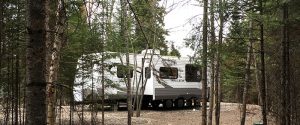
 Winter is quickly approaching and as a result, you should start preparing your RV by winterizing it. Unfortunately, winter can be quite tough on your RV due to the fact that they have plumbing and many parts that contain moisture and water that can easily get frozen and break or get severely damaged. So, properly winterizing your RV is essential so that it survives the winter and after winter when everything starts to thaw and melt.
Winter is quickly approaching and as a result, you should start preparing your RV by winterizing it. Unfortunately, winter can be quite tough on your RV due to the fact that they have plumbing and many parts that contain moisture and water that can easily get frozen and break or get severely damaged. So, properly winterizing your RV is essential so that it survives the winter and after winter when everything starts to thaw and melt.
1. Take Out The Water Filters
The very first thing that you should do is take out and bypass your RV’s in line water filters. If you add any winterization chemicals, this will likely cause your filters to get damaged. It is also best to replace the filters in fall and winter if they need to be changed out.
2. Drain The Water Tanks
Next, make sure that you don’t allow any wastewater to remain inside of your RV throughout the winter. This water can potentially freeze and cause many problems. Also, this will be the perfect place for bacteria to grow. So, make sure to drain your gray and black water tanks and do the black water tank first. After they have both been drained, make sure to clean your RV’s black tank using a cleaning wand as well as a good quality black tank cleaner.
3. Drain Out Your Water Lines & Water Heater
The next step you’ll have to take is to remove any water from the water heater in your RV. In order to remove the water, first turn off the heater and allow it to cool and de-pressurize. Once it is fully cooled, then take out the drain plug and open the valve for the pressure to reduce. This will cause all of the water to drain from your water heater. Make sure that the water is cool and the tank is de-pressurized before you attempt to drain it. After you’ve drained it, put on the hot and cold faucets completely as well as both of your drain lines. This will ensure all of the water is fully drained out.
4. Bypass Your RV’s Water Heater
Next, you will need to bypass the water heater in your RV before you add anything else. This is important to prevent antifreeze from getting into your water heater. The vast majority of RVs already have a bypass. However, if your RV doesn’t have one then you’ll need to get one installed and you can do so at Camping World.
5. Add Antifreeze
In order to add antifreeze you will need to have a water pump converter kit installed. Alternatively, you can take off the inlet side of the pump and simply put it into the container with the antifreeze. Once this is done, close all of your RV’s drain lines and faucets. Once complete, power on your water pump which will move the antifreeze into your system. Once your water system is pressurized, you should put on the hot water on each of your RV’s faucets until you can see antifreeze coming out of the faucet. Repeat with the cold water function. After, take off the water pump and open all of your RV’s faucets.
Next, take out the small screen from your city water inlet. You will need a small screwdriver in order to push on the valve so that the coolant can come out. Once done, place the screen back in its original position and close up the inlet. Make sure and throw antifreeze down each one of the sinks and drains in your RV. After all the steps above are completed, make sure that your water heater is turned off and all of the faucets have been turned off as well.

Recent Comments